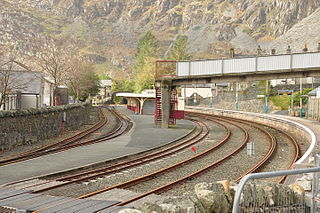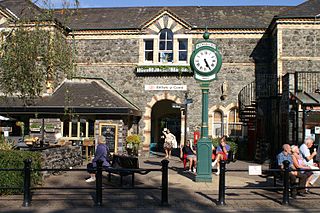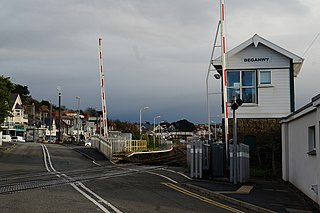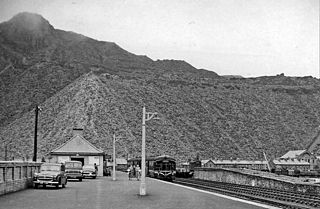
The Conwy Valley line is a railway line in north-west Wales. It runs from Llandudno via Llandudno Junction to Blaenau Ffestiniog, and was originally part of the London and North Western Railway, being opened in stages to 1879. The primary purpose of the line was to carry slate from the Ffestiniog quarries to a specially built quay at Deganwy for export by sea. The line also provided goods facilities for the market town of Llanrwst, and via the extensive facilities at Betws-y-Coed on the London to Holyhead A5 turnpike road it served many isolated communities in Snowdonia and also the developing tourist industry. Although only a little over 27 miles (43 km) between Llandudno and Blaenau Ffestiniog, the journey takes over one hour, largely due to the sinuous and steeply graded nature of the route taken. Most of the stations along the line are treated as request stops.

The North Wales Coast Line, also known as the North Wales Main Line, is a major railway line in the north of Wales, running from Crewe on the West Coast Main Line to Holyhead on the Isle of Anglesey.

Llandudno Junction, once known as Tremarl, is a town in the county borough of Conwy, Wales. It is part of the ancient parish of Llangystennin, and it is located south of Llandudno. It adjoins Deganwy and is to the east of the walled town of Conwy, which is on the opposite side of the River Conwy. The population is 6,722 (2011) and is part of the community of Conwy, and comprises the wards of Marl and Pensarn. The built-up area of Llandudno Junction and Deganwy had a population of 10,658.

Llandudno Junction railway station is on the Crewe to Holyhead North Wales Coast Line. The station is managed by Transport for Wales, although Avanti West Coast also serves it.

Betws-y-Coed railway station is a railway station on the Conwy Valley Line from Llandudno Junction to Blaenau Ffestiniog, Wales. It is situated 15 1⁄2 miles (24.9 km) south of Llandudno Junction.

Llandudno railway station serves the seaside town of Llandudno in North Wales, and is the terminus of a 3 miles (4.8 km) long branch line from Llandudno Junction on the Crewe to Holyhead North Wales Coast Line. The station is managed by Transport for Wales, who operate all trains serving it.

Deganwy railway station serves the small town of Deganwy, Wales, and is the only intermediate station located on the Llandudno branch line from Llandudno Junction to Llandudno.

Glan Conwy railway station is on the east bank of the River Conwy on A470 road in the centre of the village of Llansanffraid Glan Conwy, Wales and is located on the Llandudno Junction to Blaenau Ffestiniog Conwy Valley Line. There are through services to Blaenau Ffestiniog.

Blaenau Ffestiniog railway station serves the slate mining town of Blaenau Ffestiniog, Wales, and is the passenger terminus of the Conwy Valley Line from Llandudno Junction. Transport for Wales operate through services to Llandudno Junction and Llandudno. The station is a joint station with the narrow gauge Ffestiniog Railway, which operates primarily tourist passenger services to Porthmadog throughout most of the year. A feature of the standard gauge service is the availability on trains and buses of the popular "Gwynedd Red Rover" day ticket.
The Chester and Holyhead Railway was an early railway company conceived to improve transmission of Government dispatches between London and Ireland, as well as ordinary railway objectives. Its construction was hugely expensive, chiefly due to the cost of building the Britannia Tubular Bridge over the Menai Strait. The company had relied on Government support in facilitating the ferry service, and this proved to be uncertain. The company opened its main line throughout in 1850. It relied on the co-operation of other railways to reach London and in 1859 it was absorbed by the London and North Western Railway.
The Mold and Denbigh Junction Railway was a railway company that built a 15 3⁄4-mile (25.3 km) railway line in North Wales. It formed a link between the Mold Railway and the Vale of Clwyd Railway towards Rhyl.

Llansanffraid Glan Conwy, usually shortened to Glan Conwy, is a village, community and electoral ward in Conwy County Borough, Wales. The name translates from the Welsh as Church of St Ffraid on the bank of the River Conwy. The village was founded in the 5th century and in the past had a marine-based economy, but it is now largely residential. The population was 2,290 in 2001, reducing to 2,196 at the 2011 census. It includes the village of Pentrefelin.
The Bangor and Carnarvon Railway was a railway company promoted to build a branch railway connecting Caernarfon with the main line at Bangor, in north-west Wales. It opened in 1852 as far as Port Dinorwic and was extended to Caernarfon later in the same year.

The North Wales Mineral Railway was formed to carry coal and ironstone from the mineral-bearing area around Wrexham to the River Dee wharves. It was extended to run from Shrewsbury and formed part of a main line trunk route, under the title The Shrewsbury and Chester Railway. It opened in 1846 from Chester to Ruabon, and in 1848 from Ruabon to Shrewsbury. It later merged with the Great Western Railway.
The Mold Railway was a railway company that built a line in north-east Wales. The line linked Mold to Chester and it opened on 14 August 1849. The company built a mineral branch line to Ffrith, opened in November 1849. Mold itself was an important regional centre, and contained considerable mineral resources.
The Bethesda branch line was a 4 1⁄4-mile (6.8 km) railway branch line between Bangor and Bethesda in Gwynedd, North Wales. Its primary purpose was to bring quarried slate down to the main line for onward transport.
Blaenau Festiniog Junction railway station was the Festiniog Railway (FR)'s third of eventually five passenger stations in Blaenau Ffestiniog, then in Merionethshire, now in Gwynedd, Wales.

Blaenau Ffestiniog North was the London and North Western Railway's (LNWR's) second passenger station in Blaenau Ffestiniog, then in Merionethshire, now in Gwynedd, Wales.

On 10 September 1883 the Bala and Festiniog Railway (B&FR) and the Festiniog Railway (FR) opened what would nowadays be called an interchange station in Blaenau Ffestiniog, Merionethshire, Wales. Merionethshire is now part of the county of Gwynedd.

North west Wales experienced a slate boom in the first half of the nineteenth century. Three sites stood out as experiencing the most explosive growth: Dinorwic near Llanberis, Penrhyn near Bethesda and Blaenau Ffestiniog.














